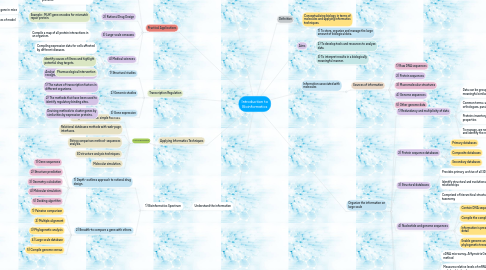
1. Understand the information
1.1. 1) Bioinformatics Spectrum
1.1.1. 1) Depth- outlines approach to rational drug design.
1.1.1.1. 1) Gene sequences
1.1.1.2. 2) Structure prediction
1.1.1.3. 3) Geometry calculation
1.1.1.4. 4) Molecular simulation
1.1.1.5. 5) Docking algorithm
1.1.2. 2) Breadth-to compare a gene with others.
1.1.2.1. 1) Pairwise comparison
1.1.2.2. 2) Multiple alignment
1.1.2.3. 3) Phylogenetic analysis
1.1.2.4. 4) Large scale database
1.1.2.5. 5) Compile genome census
2. Applying Informatics Techniques
2.1. Data Organization
2.1.1. Biological databases: simple flat files
2.1.2. Relational databases methods with web-page interfaces.
2.1.3. String comparison method- sequences analysis.
2.1.4. 3D structure analysis techniques.
2.1.5. Molecular simulation.
3. Transcription Regulation
3.1. 1) Structural studies
3.1.1. Analysis of how DNA-binding proteins recognize particular base sequences.
3.2. 2) Genomic studies
3.2.1. 1) The nature of transcription factors in different organisms.
3.2.2. 2) The methods that have been used to identify regulatory binding sites.
3.3. 3) Gene expression
3.3.1. Devising methods to cluster genes by similarities by expression proteins.
4. Practical Applications
4.1. 1) Finding homologues
4.1.1. Search for similarities between different biomolecules.
4.1.2. Transfer information between related proteins.
4.2. 2) Rational Drug Design
4.2.1. Example : MLH1 gene encodes for mismatch repair protein.
4.2.1.1. Similar to mmr gene in mice
4.2.1.2. Find homologous in databases of model organisms
4.3. 3) Large-scale censuses
4.3.1. Compile a map of all protein interactions in an organism.
4.4. 4) Medical sciences
4.4.1. Compiling expression data for cells affected by different diseases.
4.4.2. Identify causes of illness and highlight potential drug targets.
4.4.3. Pharmacological intervention
5. Conclusions
5.1. Two Principles
5.1.1. 1) Compare and group data according to biologically meaningful similarities.
5.1.2. 2) Analyze one type of data to infer and understand the observations for another type of data.
5.2. Examine individual system - highlight unusual features that are unique to some.
6. Definition
6.1. Conceptualizing biology in terms of molecules and applying informatics techniques.
7. Aims
7.1. 1) To store, organize and manage the large amount of biological data.
7.2. 2) To develop tools and resources to analyze data.
7.3. 3) To interpret results in a biologically meaningful manner.
8. Information associated with molecules
8.1. Sources of information
8.1.1. 1) Raw DNA sequences
8.1.2. 2) Protein sequences
8.1.3. 3) Macromolecular structures
8.1.4. 4) Genome sequences
8.1.5. 5) Other genome data
9. Organize the information on large scale
9.1. 1) Redundancy and multiplicity of data
9.1.1. Data can be grouped together based on meaningful similarities
9.1.2. Common terms; analogous, homologous, orthologues, paralogues
9.1.3. Proteins inventory arranged to different properties
9.1.4. To manage, we need to assess similarities and identify the related ones
9.2. 2) Protein sequence databases
9.2.1. Primary databases
9.2.2. Composite databases
9.2.3. Secondary databases
9.3. 3) Structural databases
9.3.1. Provides primary archive of all 3D structures
9.3.2. Identify structural and evolutionary relationships
9.3.3. Comprised of hierarchical structural taxonomy
9.4. 4) Nucleotide and genome sequences
9.4.1. Contain DNA sequences for individual genes
9.4.2. Compile the complete and partial genomes
9.4.3. Information is presented at several levels of detail
9.4.4. Enable genome analysis and building of phylogenetic trees
9.5. 5) Gene expression data
9.5.1. cDNA microarray, Affymatrix GeneChip, SAGE method
9.5.2. Measures relative levels of mRNA abundance and absolute levels
9.5.3. Concentrate on yeast and human genomes
9.5.4. Technologies are 2D gel electrophoresis and mass spectrometry
9.6. 6) Data integration
9.6.1. Individual informations are integrated with other data
9.6.2. By providing links that direct user to other entries

